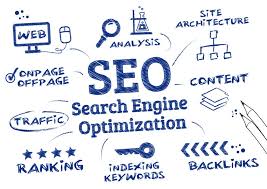Mastering the Art of SEO Optimisation: A Guide to Digital Success
The Power of SEO Optimisation
Search Engine Optimisation (SEO) is a crucial component of any successful digital marketing strategy. In today’s competitive online landscape, having a strong SEO presence can make all the difference in driving organic traffic to your website and boosting your visibility on search engine results pages.
What is SEO Optimisation?
SEO optimisation involves implementing various tactics and techniques to improve your website’s ranking on search engines like Google, Bing, and Yahoo. By optimising your site for relevant keywords, creating high-quality content, building backlinks, and enhancing user experience, you can increase your chances of appearing higher in search results.
The Benefits of SEO Optimisation
Effective SEO optimisation offers a multitude of benefits for businesses of all sizes. By improving your search engine ranking, you can attract more organic traffic to your site, generate leads, increase conversion rates, and ultimately boost revenue. Additionally, a well-executed SEO strategy can help establish your brand as an authority in your industry and build trust with your target audience.
Key Elements of SEO Optimisation
There are several key elements to consider when implementing an SEO optimisation strategy:
- Keyword Research: Identify relevant keywords that align with your business offerings and target audience.
- On-Page Optimisation: Optimise meta tags, headings, images, and content for targeted keywords.
- Off-Page Optimisation: Build quality backlinks from reputable websites to improve domain authority.
- Content Creation: Produce engaging and informative content that resonates with your audience and encourages social sharing.
- User Experience (UX): Ensure that your website is easy to navigate, mobile-friendly, and offers a seamless user experience.
The Future of SEO
In an ever-evolving digital landscape, staying ahead of the curve with SEO optimisation is essential for long-term success. As search engines continue to refine their algorithms and user behaviours shift towards mobile and voice search, adapting your SEO strategy accordingly will be key to maintaining a competitive edge.
In conclusion, investing in SEO optimisation is not just about ranking higher on search engines—it’s about enhancing the overall online presence of your business and connecting with potential customers in meaningful ways. By prioritising SEO as part of your digital marketing efforts, you can unlock new opportunities for growth and success in the digital realm.
Top 17 FAQs on SEO Optimisation: A Comprehensive Guide
- How do you Optimise for SEO?
- What is SEO and how it works?
- How SEO optimized is a website?
- What are the 3 types of SEO optimizations?
- What are the 3 C’s of SEO?
- How can I do SEO for my website?
- How do I optimize my SEO content?
- What is optimization in SEO?
- What are the 3 types of SEO?
- How do I SEO optimize?
- How is SEO optimization done?
- What is SEO and optimization?
- How do I optimize my SEO page?
- How do I optimize SEO performance?
- What is SEO method?
- What is SEO & How it works?
- How do I make SEO optimized?
How do you Optimise for SEO?
Optimising for SEO involves a strategic approach to improving your website’s visibility on search engines. To optimise for SEO effectively, start by conducting thorough keyword research to identify relevant terms that align with your business and target audience. Next, focus on on-page optimisation by incorporating these keywords into meta tags, headings, and high-quality content. Building a strong backlink profile from reputable websites and enhancing user experience through mobile responsiveness and site speed are also crucial aspects of SEO optimisation. Regularly monitoring performance metrics and staying informed about search engine algorithm updates are key to maintaining a successful SEO strategy that drives organic traffic and boosts your online presence.
What is SEO and how it works?
Search Engine Optimisation (SEO) is a fundamental digital marketing strategy aimed at enhancing a website’s visibility on search engine results pages. SEO works by optimising various aspects of a website, including content, keywords, meta tags, and backlinks, to improve its ranking in organic search results. By aligning with search engine algorithms and user intent, SEO helps websites attract more relevant traffic and increase their online presence. Ultimately, SEO is about creating a seamless user experience and providing valuable information to users while meeting the criteria set by search engines for ranking websites effectively.
How SEO optimized is a website?
When evaluating how SEO optimized a website is, various factors come into play to determine its level of optimization. These factors include the website’s keyword usage, meta tags, content quality and relevance, backlink profile, site speed, mobile-friendliness, user experience, and overall technical structure. Conducting a comprehensive SEO audit can provide insights into the strengths and weaknesses of a website’s optimization efforts, highlighting areas for improvement to enhance its search engine visibility and organic traffic potential. Regular monitoring and adjustments based on SEO best practices are essential to ensure that a website remains highly optimized for improved performance in search engine results pages.
What are the 3 types of SEO optimizations?
When it comes to SEO optimisation, there are three main types that businesses typically focus on: on-page SEO, off-page SEO, and technical SEO. On-page SEO involves optimising individual web pages with relevant keywords, quality content, meta tags, and internal linking to improve their visibility on search engine results pages. Off-page SEO, on the other hand, focuses on building high-quality backlinks from reputable websites to enhance domain authority and increase organic traffic. Lastly, technical SEO involves improving website infrastructure, such as site speed, mobile-friendliness, and schema markup, to ensure optimal crawling and indexing by search engines. By incorporating all three types of SEO optimisations into their strategy, businesses can create a well-rounded approach that boosts their online presence and drives sustainable growth.
What are the 3 C’s of SEO?
The 3 C’s of SEO refer to Content, Code, and Credibility. These fundamental pillars play a crucial role in enhancing a website’s search engine visibility and overall performance. Content involves creating high-quality, relevant, and engaging material that resonates with both users and search engines. Code refers to the technical aspects of a website, such as optimising HTML structure, meta tags, and site speed to ensure seamless crawling and indexing by search engine bots. Credibility focuses on building authority through backlinks from reputable sources, establishing trust with users, and adhering to ethical SEO practices for long-term success in the digital landscape. Mastering the 3 C’s of SEO is essential for achieving sustainable organic growth and maximising online visibility.
How can I do SEO for my website?
To effectively do SEO for your website, it is essential to start with thorough keyword research to identify relevant search terms that align with your business offerings. Optimise your website’s on-page elements such as meta tags, headings, and content by incorporating these keywords strategically. Additionally, focus on building quality backlinks from reputable websites to enhance your site’s authority. Regularly create high-quality, engaging content that resonates with your target audience and encourages organic sharing. Prioritise user experience by ensuring your website is mobile-friendly, easy to navigate, and offers valuable information. Monitoring and analysing the performance of your SEO efforts through tools like Google Analytics is crucial for making data-driven decisions and continually improving your website’s search engine visibility.
How do I optimize my SEO content?
Optimising your SEO content involves a strategic approach to ensure that your web pages are not only visible but also valuable to both search engines and users. To optimise your SEO content effectively, start by conducting thorough keyword research to identify relevant terms and phrases that align with your target audience’s search intent. Incorporate these keywords naturally into your content, including titles, headings, meta descriptions, and body text. Focus on creating high-quality, engaging content that addresses the needs of your audience while providing value and insights. Additionally, optimise your images with descriptive alt tags, improve internal linking structure for easy navigation, and regularly update and refresh your content to maintain relevance and authority in search engine rankings. By following these best practices, you can enhance the visibility and performance of your SEO content for improved organic traffic and user engagement.
What is optimization in SEO?
Optimization in SEO refers to the process of refining and improving various aspects of a website to enhance its visibility and ranking on search engine results pages. This involves strategically implementing on-page and off-page tactics such as keyword research, content creation, meta tag optimization, link building, and improving user experience. By optimising these elements according to search engine algorithms and best practices, websites can attract more organic traffic, increase their online presence, and ultimately achieve better performance in search engine rankings. Optimization in SEO is a continuous effort that requires attention to detail, analysis of data, and adaptation to evolving trends to ensure long-term success in the digital landscape.
What are the 3 types of SEO?
When it comes to SEO optimisation, understanding the different types of SEO is essential for crafting a comprehensive digital marketing strategy. The three main types of SEO are on-page SEO, off-page SEO, and technical SEO. On-page SEO focuses on optimising individual web pages to improve their search engine ranking through content creation, keyword usage, and meta tags. Off-page SEO involves building quality backlinks from external websites to enhance domain authority and credibility. Technical SEO, on the other hand, deals with website infrastructure and performance aspects like site speed, mobile-friendliness, and schema markup to ensure optimal crawling and indexing by search engines. By incorporating all three types of SEO into your strategy, you can maximise your online visibility and drive organic traffic to your website effectively.
How do I SEO optimize?
To SEO optimize effectively, it is essential to start by conducting thorough keyword research to identify relevant terms that align with your business goals and target audience. Next, focus on on-page optimisation by incorporating these keywords strategically into your website’s meta tags, headings, and content. Building quality backlinks from reputable sources and creating engaging, informative content are also crucial aspects of SEO optimisation. Additionally, ensure that your website offers a seamless user experience, is mobile-friendly, and loads quickly. Regularly monitoring and analysing your SEO efforts through tools like Google Analytics can help you refine your strategy for optimal results. Remember that SEO optimisation is an ongoing process that requires dedication and adaptability to stay ahead in the ever-evolving digital landscape.
How is SEO optimization done?
SEO optimization is a multifaceted process that involves various strategies and techniques to improve a website’s visibility on search engines. The key steps in SEO optimization include conducting thorough keyword research to identify relevant terms, optimizing on-page elements such as meta tags and content, building quality backlinks from authoritative sites, creating high-quality and engaging content, and ensuring a seamless user experience. By implementing these tactics effectively and staying abreast of search engine algorithms, businesses can enhance their online presence, attract organic traffic, and ultimately improve their search engine rankings.
What is SEO and optimization?
SEO, short for Search Engine Optimisation, is the practice of enhancing a website’s visibility on search engine results pages through organic, non-paid methods. It involves a range of strategies aimed at improving a site’s ranking for specific keywords relevant to its content and target audience. On the other hand, optimisation refers to the process of refining various elements of a website to make it more search engine-friendly and user-friendly. This includes on-page optimisation techniques such as keyword integration, meta tag optimisation, and content improvement, as well as off-page strategies like link building and social media engagement. Together, SEO and optimisation work hand in hand to boost a website’s online presence, drive organic traffic, and ultimately improve its performance in search engine rankings.
How do I optimize my SEO page?
Optimising your SEO page involves a strategic approach to enhance its visibility and ranking on search engine results pages. To optimise your SEO page effectively, start by conducting thorough keyword research to identify relevant terms that align with your content and target audience. Incorporate these keywords naturally into your page title, meta description, headings, and body content to signal search engines about the relevance of your page. Additionally, focus on creating high-quality, engaging content that provides value to users and encourages them to stay on your page longer. Optimising images with descriptive alt text, improving page load speed, and obtaining quality backlinks from reputable sites are also essential aspects of optimising your SEO page for better performance in search results. By following these best practices and staying updated on the latest SEO trends, you can boost the visibility and effectiveness of your SEO page.
How do I optimize SEO performance?
Optimising SEO performance involves a strategic approach to improving your website’s visibility and ranking on search engine results pages. To enhance your SEO performance, it is essential to conduct thorough keyword research to identify relevant terms that align with your content and target audience. Implementing on-page optimisation techniques such as optimising meta tags, headings, and content for targeted keywords is crucial. Additionally, creating high-quality, engaging content that provides value to users and encourages sharing can significantly boost SEO performance. Building quality backlinks from reputable websites, ensuring a mobile-friendly website design, and monitoring analytics data to track progress are also key factors in optimising SEO performance effectively. By combining these strategies with consistent monitoring and adjustments based on performance metrics, you can enhance your SEO performance and drive organic traffic to your website successfully.
What is SEO method?
SEO method refers to the specific strategies and techniques used to improve a website’s visibility and ranking on search engine results pages. It encompasses a range of practices such as keyword research, on-page optimisation, link building, content creation, and technical SEO. Each method aims to enhance the relevance and authority of a website in the eyes of search engines like Google, ultimately driving organic traffic and increasing online visibility. By implementing effective SEO methods tailored to your business goals, you can strengthen your online presence and attract valuable visitors who are actively searching for products or services that you offer.
What is SEO & How it works?
Search Engine Optimisation (SEO) is a fundamental digital marketing strategy aimed at improving a website’s visibility on search engine results pages. In essence, SEO works by optimising various aspects of a website, such as content, keywords, meta tags, and backlinks, to align with search engine algorithms and user intent. By strategically implementing SEO tactics, businesses can enhance their online presence, attract organic traffic, and ultimately increase their chances of ranking higher in search results. SEO is an ongoing process that requires continuous monitoring, analysis, and adaptation to stay ahead of the competition and meet the evolving demands of search engines.
How do I make SEO optimized?
To make your website SEO optimized, you need to focus on several key aspects. Firstly, conduct thorough keyword research to identify relevant terms that your target audience is searching for. Incorporate these keywords strategically into your website’s meta tags, headings, and content to improve visibility on search engine results pages. Ensure that your site’s structure is user-friendly and easy to navigate, as this can positively impact both user experience and search engine rankings. Additionally, regularly update your content with high-quality, engaging material that provides value to your audience. Building quality backlinks from reputable websites can also boost your site’s authority in the eyes of search engines. By implementing these SEO best practices consistently and staying informed about industry trends, you can effectively make your website SEO optimized and increase its online presence.


